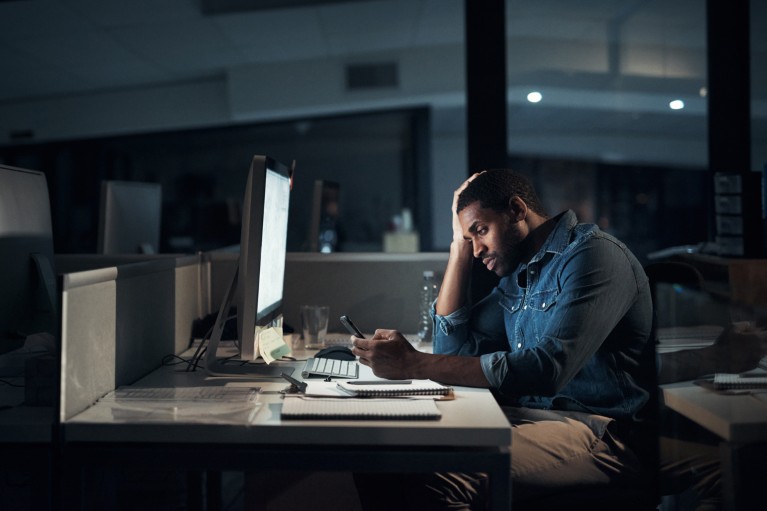Digital devices are proliferating but don’t always have the positive effect on productivity researchers might hope.Credit: Getty
Video calls. Instant messaging. Voice calls. E-mails. Social media. Smartphones. Tablets. Laptops. Desktops. More digital devices equals less time to concentrate and to think. The negative effects of this on researchers are tackled by computer scientist Cal Newport in his latest book, Slow Productivity1.
The book’s title challenges the idea, common to many workplaces, that productivity must always increase. A study has shown that science is becoming less disruptive, even though there are now more papers being published and grants awarded than ever before2. Newport, who studies technology in the workplace at Georgetown University in Washington DC, says that researchers and other knowledge workers need to slow down and spend more time thinking, to focus on maintaining and improving quality in their work.
Newport does the research community a service by shining a spotlight on an overburdened workforce. Institutions should already be accessing the expertise that exists within their walls in the search for answers, but are not doing so. Newer communications technologies have enormous benefits, including speeding up research, as was necessary during the COVID-19 pandemic. But they are also squeezing out thinking time. Newport’s book reminds us that there are researchers who will know how to help.
Stop, drop and think
Thinking time — the time needed to concentrate without interruptions has always been central to scholarly work. It is essential to designing experiments, compiling data, assessing results, reviewing literature and, of course, writing. Yet, thinking time is often undervalued; it is rarely, if ever, quantified in employment practices.

Is science really getting less disruptive — and does it matter if it is?
One way to think about the practice of juggling research with e-mail and instant messaging is to visualize someone working next to a physical letterbox. Imagine opening and reading every letter as soon as it arrives, and starting to compose a reply, even as more letters drop through the box — all the while trying to do your main job. Researchers say that their to-do lists tend to lengthen, in part because colleagues can contact them instantly, often for good reasons. Researchers also often have to choose what to prioritize, which can cause them to feel overwhelmed.
Newport gives suggestions on reclaiming thinking time, include limiting the number of items on to-do lists and project teams setting aside time to complete tasks that require all members, thus avoiding individual members sending e-mails to each other. For institutions, Newport recommends a transparent workload management system — a way for managers to see everything that a colleague is expected to do — and then to adjust the workload if there are more tasks than there is available time.
Undoubtedly good advice, this might be easier to implement in industrial settings than in academic ones. In many academic research laboratories, researchers report to a single principal investigator, with little management structure. This is partly because it is hard to justify to academic funders the budget for paying for management and administration roles.

Is science’s dominant funding model broken?
But Felicity Mellor, a science-communication researcher at Imperial College London, is sceptical about giving managers a role in thinking time. In many cases, researchers are already feeling the weight of their institution’s monitoring and evaluation systems. Mellor argues that including yet another box in an evaluation form might not go down well. She also thinks that institutions will not accept this. “Can you imagine the response if a scientist filled out a time sheet where it says ‘eight hours spent thinking’?” Ultimately, she says, creating a more supportive research culture needs a much more fundamental change. That suggests an even more radical rethink of the current funding model for academic research, as we wrote last month (see Nature 630, 793; 2024), along with changes to other aspects of academic science.
Quality check
Newport’s thesis raises a much more fundamental question: what is the impact of lost concentration time on science — not just on the structure and process of science, but also on the content and quality of research?
In 2014, Mellor co-led a research project, funded by the UK Arts and Humanities Research Council, called The Silences of Science, published as a book two years later3. Researchers discussed this question, and others in a series of workshops, but the work did not continue after the grant expired. Such explorations need to be revived, but they also need to incorporate the impact of artificial-intelligence technologies. These tools are being implemented at pace around the world to automate many routine administrative tasks. Researchers need to evaluate whether such tools can free up more thinking time for researchers; or whether they could have the opposite effect.
Communications technologies are sure to evolve further and to continue distracting researchers from their work. More studies investigating the effect of these technologies on science are needed urgently, as are studies on how thinking time can be protected in a world of instant communication. This knowledge will help researchers and institutional leaders to make better decisions about the technologies’ deployment — and, hopefully, allow researchers to carve out that all-important space and time to think.
